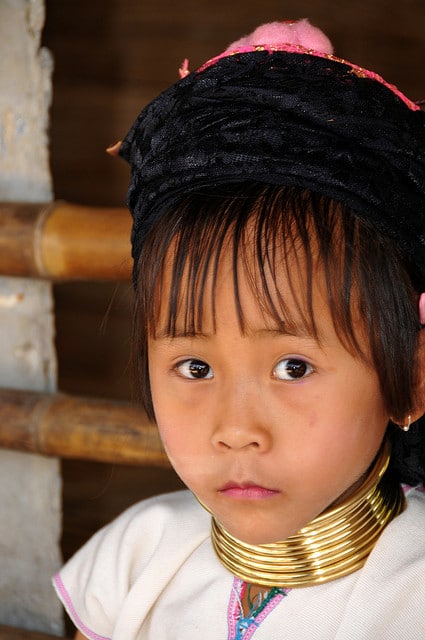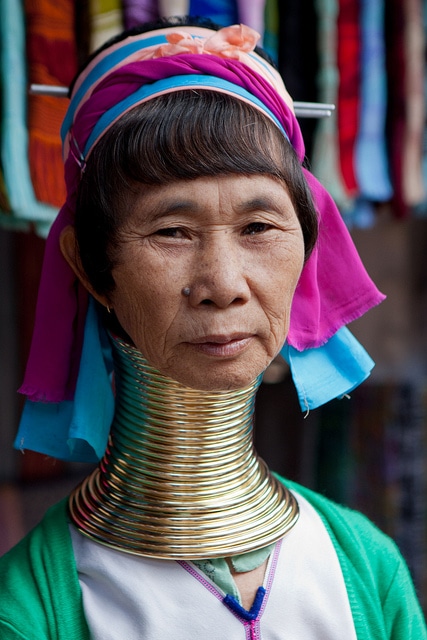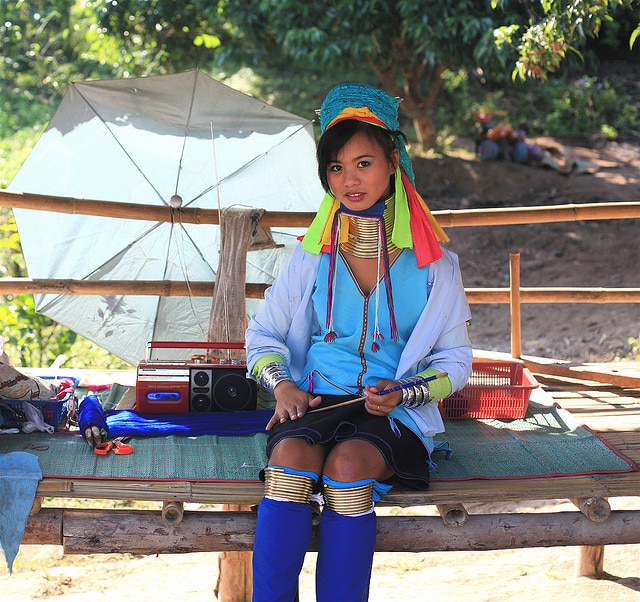
For some tourists, seeing the giraffe-like, long neck women Kayans may seem like just another stop on a Thailand adventure of a lifetime. Many tourist agencies stop by these hill villages between jeep rides through snake-infested jungles and tours of elegant temples. Visitors pile out for a quick photo opportunity with exotic-looking women before tour guides shuttle the group to the next destination.
Who are these women? And should you support this controversial tourism attraction?

Kayan child. Photo courtesy of archer10(Dennis).
Who Are The Kayans?
Two decades ago, an intensifying civil war between Karenni separatists and the Burmese army caused Kayar residents to flee Myanmar. Thailand granted the Kayan temporary stay under “conflict refugee” status. Now, the 500 or so Kayans (also known as Padaung people) live in guarded villages on the northern Thai border.
The tribe has a custom where some women wearing rings to create the appearance of a long neck. This exotic tradition inspired the creation of tourism villages in 1985. Some Padaung moved to these artificial hill tribe residencies with work permits to make a living on tourism. But without citizenship, Kayans have limited access to utilities such as electricity, roads, health care and schools for education. Furthermore, Thai authorities refuse to allow Kayans to resettle outside tourist villages, claiming they are economic migrants and not real refugees.
The Rings
Kayan long neck women wear the rings from childhood, starting with four or five, and adding more annually as they acclimate to the increased weight. Coils weighing up to 25 pounds depress the chest and shoulders. This creates the illusion of disembodied head hovering over a shimmering pedestal of gold rings. Contrary to popular belief, the coils don’t lengthen the neck itself and thus can be removed without the neck snapping. Yet, women still wear these coils year round with few exceptions, even while sleeping.
The origin of the tradition mystifies even the Kayans. An ancient legend claims rings protected villagers from tiger attacks, since the cats attack victims at the neck. Another theory said the rings helped ward off men from rival tribes by lessening the women’s beauty. Today, people believe the opposite– the longer their neck, the more beautiful the woman—and Kayans wear the golden coils as an accessory. According to the Silent Hopes documentary (shown above), some women enjoy upholding this tradition but others feel pressured to endure the painful custom to make a living. Human rights groups claim the refugee status exploits women who can’t find other work.

Kayan woman. Photo courtesy of beggs.
Hill Tribe Tourism
An estimated 40,000 tourists per year pay between $8-16 to stop by these hill tribe villages to gaze upon the women’s unusual appearance and take pictures. Unfortunately, the entry fee is rarely dispensed to the villagers directly. Instead, neck-ring-wearing-women sell trinkets, crafts and photo-ops, essentially working in a live-in gift shop. Residents receive an allowance of food and toiletries and profit from handicraft sales, and women wearing brass rings earn an extra salary. Village owners decrease wages if women discuss their plight with visitors or use anything modern, like cell phones or computers.
While some say the villages give Kayans a paid opportunity to retain their culture, others condemn this arrangement for exploiting stateless women and children in exchange for tourist dollars.
Although the ethics of this arrangement makes some travelers uncomfortable, each day, vanloads of curious foreigners still visit long neck villages. Many foreign-run companies discourage these trips but most Thai-based companies don’t discriminate. Over a half-dozen hill tribes exist in North Thailand and the Chiang Mai province.

Young Kayan artist. Photo courtesy of jurvetson.
Should You Go?
Can you justify ethical travel to these villages? Yes, if you do your research. Most women view tourist visits as a way to make a living since their non-resident status limits employment opportunities; however, sensationalizing dress, customs, and unique traditions of these people mean nothing if they are treated inhumanly.
If you chose to visit, follow these recommendations to make it a better experience:
▪ Do your research and find a responsible tour company that will promote a socially responsible visit. Private guides can bring you to their own villages.
▪ Make sure your money benefits the village directly instead of third party companies. If you’re not sure, insist you give money to the chief of the village or support the women by purchasing their handicrafts.
▪ Don’t just stop by for a photo shoot. Try to extend your stay to learn about the people and hear their stories.
▪ Consider volunteering in a village.
The goal of travel shouldn’t be taking pictures of exotic things to brag about back home. Travel is about forging relationships and making connections with people from different cultures. Create a symbiotic relationship with locals by reaching out to find common ground with the people you met, instead of treating them as spectacles to exploit.
Top photo: Kayan woman weaving. Photo courtesy of beggs.

Jessica Festa is the editor of the travel sites Jessie on a Journey (http://jessieonajourney.com) and Epicure & Culture (http://epicureandculture.com). Along with blogging at We Blog The World, her byline has appeared in publications like Huffington Post, Gadling, Fodor’s, Travel + Escape, Matador, Viator, The Culture-Ist and many others. After getting her BA/MA in Communication from the State University of New York at Albany, she realized she wasn’t really to stop backpacking and made travel her full time job. Some of her most memorable experiences include studying abroad in Sydney, teaching English in Thailand, doing orphanage work in Ghana, hiking her way through South America and traveling solo through Europe. She has a passion for backpacking, adventure, hiking, wine and getting off the beaten path.








